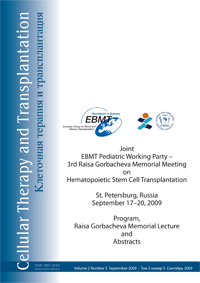High-dose chemotherapy and autologous stem cell transplantation in children with Ewing’s sarcoma/PNET
Ilya V. Kazantsev1, Tatjana V. Youhta2, Elena V. Morozova1, Svetlana A. Safonova2, Yury A. Punanov2, Liudmila S. Zubarovskaya1, Boris V. Afanasyev1
1Memorial R. M. Gorbacheva Institute of Children Hematology and Transplantation, St. Petersburg Pavlov State Medical University,
St. Petersburg, Russia; 2Federal State Institution N.N. Petrov Research Institute of Oncology, Saint Petersburg
Correspondence
Ilya V. Kazantsev, Comissara Smirnova str., 10a, 32, St. Petersburg, 194044, Russia, Phone: +7 (921) 317-47-49
E-mail: Ilya_Kazantsev@inbox.ru
Summary
The clinical course of Ewing’s sarcoma/PNET in children is characterized by a rapid increase of tumor mass and early metastases. In this context a substantial part of the affected pediatric population – children with clinically detectable metastatic disease or heavy tumor burden – has a poor prognosis. Although contemporary therapy programs – those that combine systemic chemotherapy with local control measures – achieve 5-year event-free survival (EFS) in 70–80% of children with localized disease, the results in high-risk groups are still to be improved with a 5-year EFS rate of 20–30%. Some research data provides evidence of high-dose chemotherapy (HDCT) with autologous hematopoietic stem cell transplantation (auto-HSCT) being a promising option for treatment of these high-risk patients.
Patients and methods
From 2003 to December 2008 a total of 17 pediatric patients with Ewing’s sarcoma/PNET received HDCD with auto-HSCT. There were 11 males and 6 females (male-female ratio of 1.8:1) with a median age at diagnosis of 13.4 yrs (range 3–18 yrs). In all the cases, diagnosis was histologically proved. Of the 17 patients, 13 had metastatic disease and 4 had localized disease. In all the patients with localized disease the initial tumor volume exceeded 200 sm3. In all the cases the therapy program included 6 courses of polychemotherapy (ifosfamide, vincristine, doxorubicin and etoposide), surgical treatment or local irradiation of primary disease sight (48–56 Gy). There were 8 patients who received 8 courses of maintenance chemotherapy (vincristine, dactinomycin, ifosfamide). In 9 cases the maintenance therapy was substituted for HDCT with auto-HSCT. We used the following conditioning regimens: oral busulfan 16 mg/kg and melphalan 140 mg/m2 in 7 patients and melphalan 140–200 mg/m2 in 2 patients. We used different stem cell sources: bone marrow (BM) in 5 patients, peripheral blood stem cells (PBSC) in 2 patients, and BM and PBSC – due to the poor yield of SC – in 2 patients. A mean dose of CD34+ cells in the graft amounted to 3.26 x 106 (range 1.0–8.9 x 106).
Results
In the maintenance therapy group (n=8) 5 patients had a relapse of metastatic disease and died of tumor progression, 2 patients had a local relapse and received salvage therapy – in one case, HDCT with auto-HSCT – and both are presently disease–free, while 1 patient died of overwhelming sepsis.
In the HDCT group (n=9) 8 of the patients are alive – 1 died of disease progression – 4 patients remain in remission, 2 patients failed to achieve remission and received allogeneic HSCT, and 2 patients relapsed 2–8 months after HDCT with auto-HSCT. All children transplanted in partial remission or disease progression later relapsed. All of the children that are at the moment disease-free were diagnosed stage IV Ewing’s sarcoma– distant metastases at the time of diagnosis – but achieved complete remission (CR) at the end of the induction chemotherapy course. The toxicity of HDCT regimens was moderate: all of the patients had grade II–III mucositis, 6 patients had febrile neutropenia, and 2 patients had toxic hepatitis.
Conclusions
HDCT with auto-HSCT in high-risk group children with Ewing’s sarcoma/PNET has acceptable toxicity and allows improved PFS for patients in CR after standard therapy regimens.
Keywords
Ewing's sarcoma, PNET, autologous hematopoietic stem cell transplantation, maintenance therapy
Table 1.
|
Patient groups |
PFS (3–32 months) |
OS (3–32 months) |
Causes of death |
|
|---|---|---|---|---|
|
Progression |
Sepsis |
|||
|
Maintenance (n=8) |
12.5% (n=1) |
25% (n=2) |
83% (n=5) |
16% (n=1) |
|
Auto-HSCT (n=9) |
44% (n=4) |
89% (n=7) |
11% (n=1) |
- |
|
- CR (n=5) |
80% (n=4) |
100% (n=5) |
- |
- |
|
- PR/progression (n=4) |
0% |
75% (n=3) |
100% (n=1) |
- |


